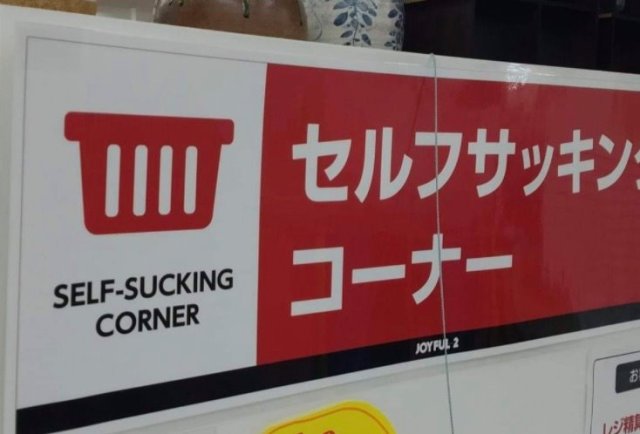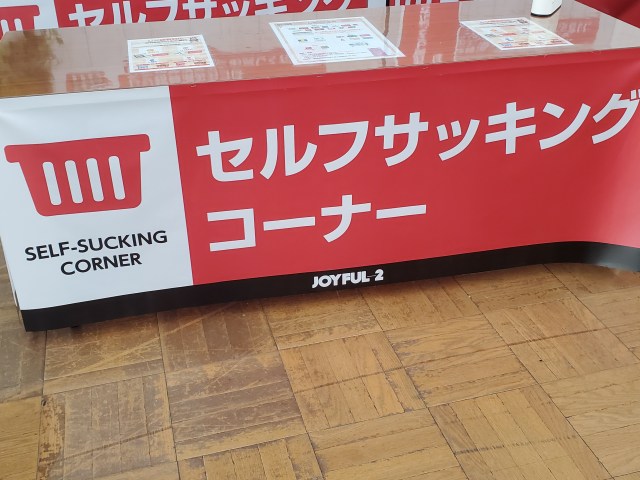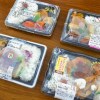
This isn’t the type of self-service they were meaning.
Japan is scattered with well-intended English-language signs that contain seemingly obvious translation mistakes, with even big companies like Pizza Hut and Osaka Metro proving that the simplest of messages run the risk of becoming lost in translation.
These “Engrish” mistakes, as they’re known, often make native English speakers smile, but one recent find had people blushing in embarrassment instead. That’s because a chainstore in Japan decided it was okay to display this:

That’s right — a section of the Arakawaoki branch of the Joyful 2 hobby specialty store, located at Tsuchiura in Ibaraki Prefecture, had a sign that read “Self-Sucking Corner“. And that’s not the only branch where the sign was displayed, as it was also photographed at the chain’s Chiba New Town branch in Inzai, Chiba Prefecture.
Image: Blain Armstrong
While the English sign was intended as a nice gesture designed to help English-speaking customers, it no doubt left them scratching their heads instead. While “self-sucking corner” gives a whole other meaning to “Joyful 2”, the actual act of self-sucking in a corner of the store would be legally off-limits, and likely physically impossible, so what were they really aiming to convey with this sign?
The reason for the mistake is revealed in the katakana message printed next to it, which reads phonetically as “self-sacking corner“. The problem occurs with the word “サッキング”, as the (sa) sounds similar to the “su” in the English word for “suck”, so much so that a search for “サッキングパッド” (read phonetically as “sacking pad“) on Google will take you to “sucking pads”, a product designed to be added as an attachment to baby carriers for babies to suck on.
With the katakana word for “sack” being used to mean “suck” in some cases, and “sack” at other times, the confusion between the two words becomes understandable. Still, the store sign was so noteworthy for its hilarious mistake that it even made its way to Japanese sites, where Japanese commenters had a laugh at the sign as well.
“So…what happens if I self-suck at the self-sucking corner?”
“My body isn’t supple enough for this store.”
“Mistaking “u” and “a” can make a huge difference!”
“Businesses should really avoid posting signs they don’t understand themselves!”
“It’s hard to tell the difference in pronunciation between ‘sucking’ and ‘sacking’.”
It’s true that these small nuances in pronunciation make it difficult for Japanese speakers to differentiate between the two words, especially when it comes to speaking and listening. It’s one of the many reasons why Engrish exists and continues to this day, even creating blunders that include making Kyoto the enemy of the world. Oops!
Source: Hachima Kikou
Featured image: Pakutaso
Insert images used with permission
● Want to hear about SoraNews24’s latest articles as soon as they’re published? Follow us on Facebook and Twitter!


 Engrish sign at the Tokyo Olympics turns out to be hilariously accurate
Engrish sign at the Tokyo Olympics turns out to be hilariously accurate Japanese elementary school student teaches us all how to pronounce English like a native speaker
Japanese elementary school student teaches us all how to pronounce English like a native speaker English mistake makes Kyoto the enemy of the world
English mistake makes Kyoto the enemy of the world This squirrel is sub-par! More nonsense Japanese hits the fashion market
This squirrel is sub-par! More nonsense Japanese hits the fashion market Seven mistakes foreigners make when speaking Japanese—and how to fix them
Seven mistakes foreigners make when speaking Japanese—and how to fix them Foreigner’s request for help in Tokyo makes us sad for the state of society
Foreigner’s request for help in Tokyo makes us sad for the state of society Seaside scenery, history, and so many desserts on Yokohama’s Akai Kutsu【Japan Loop Buses】
Seaside scenery, history, and so many desserts on Yokohama’s Akai Kutsu【Japan Loop Buses】 Mikado Coffee is a 76-year-old coffee chain with a major celebrity connection
Mikado Coffee is a 76-year-old coffee chain with a major celebrity connection Japanese city loses residents’ personal data, which was on paper being transported on a windy day
Japanese city loses residents’ personal data, which was on paper being transported on a windy day Ghibli Park now selling “Grilled Frogs” from food cart in Valley of Witches
Ghibli Park now selling “Grilled Frogs” from food cart in Valley of Witches This is the first cafe in Japan to serve Mont Blanc, and it’s closing down after 90 years【Taste test】
This is the first cafe in Japan to serve Mont Blanc, and it’s closing down after 90 years【Taste test】 Japanese politician’s birthrate plan: Have parents nag their kids to have “at least three babies”
Japanese politician’s birthrate plan: Have parents nag their kids to have “at least three babies” In Memory of the Victims of the 2011 Tohoku Earthquake and Tsunami
In Memory of the Victims of the 2011 Tohoku Earthquake and Tsunami Tokyo Disneyland Hosts Its First Gay Wedding
Tokyo Disneyland Hosts Its First Gay Wedding We taste makunouchi bento at four Japanese convenience store chains【Taste comparison】
We taste makunouchi bento at four Japanese convenience store chains【Taste comparison】 McDonald’s new Happy Meals offer up cute and practical Sanrio lifestyle goods
McDonald’s new Happy Meals offer up cute and practical Sanrio lifestyle goods Japanese ramen restaurants under pressure from new yen banknotes
Japanese ramen restaurants under pressure from new yen banknotes French Fries Bread in Tokyo’s Shibuya becomes a hit on social media
French Fries Bread in Tokyo’s Shibuya becomes a hit on social media Red light district sushi restaurant in Tokyo shows us just how wrong we were about it
Red light district sushi restaurant in Tokyo shows us just how wrong we were about it New private rooms on Tokaido Shinkansen change the way we travel from Tokyo to Kyoto
New private rooms on Tokaido Shinkansen change the way we travel from Tokyo to Kyoto Tokyo Tsukiji fish market site to be redeveloped with 50,000-seat stadium, hotel, shopping center
Tokyo Tsukiji fish market site to be redeveloped with 50,000-seat stadium, hotel, shopping center Beautiful Ghibli sealing wax kits let you create accessories and elegant letter decorations【Pics】
Beautiful Ghibli sealing wax kits let you create accessories and elegant letter decorations【Pics】 Secret Kitchen bento serves Japanese flowers, birds, wind and moon in a box, but is it worth it?
Secret Kitchen bento serves Japanese flowers, birds, wind and moon in a box, but is it worth it? New definition of “Japanese whiskey” goes into effect to prevent fakes from fooling overseas buyers
New definition of “Japanese whiskey” goes into effect to prevent fakes from fooling overseas buyers Our Japanese reporter visits Costco in the U.S., finds super American and very Japanese things
Our Japanese reporter visits Costco in the U.S., finds super American and very Japanese things Studio Ghibli releases Kiki’s Delivery Service chocolate cake pouches in Japan
Studio Ghibli releases Kiki’s Delivery Service chocolate cake pouches in Japan All-you-can-drink Starbucks and amazing views part of Tokyo’s new 170 meter-high sky lounge
All-you-can-drink Starbucks and amazing views part of Tokyo’s new 170 meter-high sky lounge More foreign tourists than ever before in history visited Japan last month
More foreign tourists than ever before in history visited Japan last month New Pokémon cakes let you eat your way through Pikachu and all the Eevee evolutions
New Pokémon cakes let you eat your way through Pikachu and all the Eevee evolutions Disney princesses get official manga makeovers for Manga Princess Cafe opening in Tokyo
Disney princesses get official manga makeovers for Manga Princess Cafe opening in Tokyo Sales of Japan’s most convenient train ticket/shopping payment cards suspended indefinitely
Sales of Japan’s most convenient train ticket/shopping payment cards suspended indefinitely Sold-out Studio Ghibli desktop humidifiers are back so Totoro can help you through the dry season
Sold-out Studio Ghibli desktop humidifiers are back so Totoro can help you through the dry season Japanese government to make first change to romanization spelling rules since the 1950s
Japanese government to make first change to romanization spelling rules since the 1950s Ghibli founders Toshio Suzuki and Hayao Miyazaki contribute to Japanese whisky Totoro label design
Ghibli founders Toshio Suzuki and Hayao Miyazaki contribute to Japanese whisky Totoro label design Doraemon found buried at sea as scene from 1993 anime becomes real life【Photos】
Doraemon found buried at sea as scene from 1993 anime becomes real life【Photos】 Tokyo’s most famous Starbucks is closed
Tokyo’s most famous Starbucks is closed One Piece characters’ nationalities revealed, but fans have mixed opinions
One Piece characters’ nationalities revealed, but fans have mixed opinions We asked a Uniqlo employee what four things we should buy and their suggestions didn’t disappoint
We asked a Uniqlo employee what four things we should buy and their suggestions didn’t disappoint Pokémon Center apologizes for writing model Nicole Fujita’s name as Nicole Fujita
Pokémon Center apologizes for writing model Nicole Fujita’s name as Nicole Fujita Yahoo! Japan finds most alphabetic and katakana words Japanese people want to find out about
Yahoo! Japan finds most alphabetic and katakana words Japanese people want to find out about Hit Japanese app Crabhouse forced to change name on iOS
Hit Japanese app Crabhouse forced to change name on iOS Japanese company Yellow Hat hilariously mistakes Pizza Hut for Italian dish-themed headwear
Japanese company Yellow Hat hilariously mistakes Pizza Hut for Italian dish-themed headwear The science behind why English speakers can’t pronounce the Japanese “fu”
The science behind why English speakers can’t pronounce the Japanese “fu” English conversation school in Japan has clever reminder that students don’t have to be perfect
English conversation school in Japan has clever reminder that students don’t have to be perfect “We wasted so much time in English class” — Japanese Twitter user points out major teaching flaw
“We wasted so much time in English class” — Japanese Twitter user points out major teaching flaw “Japanese English” can baffle native English speakers — but what about Korean speakers? 【Video】
“Japanese English” can baffle native English speakers — but what about Korean speakers? 【Video】 We visited Japan’s number one udon store in Gunma Prefecture
We visited Japan’s number one udon store in Gunma Prefecture Message to foreigners at Japanese convenience store sparks controversy online
Message to foreigners at Japanese convenience store sparks controversy online Foreigner accused of shoplifting tea in Japan, label to blame 【Why Does Engrish Happen in Japan?】
Foreigner accused of shoplifting tea in Japan, label to blame 【Why Does Engrish Happen in Japan?】 Japanese convenience store apologizes for putting Meatballs in meatball packages, issues recall
Japanese convenience store apologizes for putting Meatballs in meatball packages, issues recall Top 10 most irritating Japanese borrowed words – Part 2 (The people’s top 10)
Top 10 most irritating Japanese borrowed words – Part 2 (The people’s top 10) Starbucks Japan opens first sign-language store in Tokyo
Starbucks Japan opens first sign-language store in Tokyo Learn Japanese through ridiculous manga: A Tick on Titan 【Episode #3】
Learn Japanese through ridiculous manga: A Tick on Titan 【Episode #3】 Sushi store makes waves in Japan for meal with a surprising 14-character katakana name
Sushi store makes waves in Japan for meal with a surprising 14-character katakana name People wowed by Japanese road signs that change automatically in seconds 【Videos】
People wowed by Japanese road signs that change automatically in seconds 【Videos】
Leave a Reply